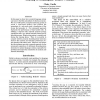Free Online Productivity Tools
i2Speak
i2Symbol
i2OCR
iTex2Img
iWeb2Print
iWeb2Shot
i2Type
iPdf2Split
iPdf2Merge
i2Bopomofo
i2Arabic
i2Style
i2Image
i2PDF
iLatex2Rtf
Sci2ools
AAAI
1992
1992
Learning to Disambiguate Relative Pronouns
In this paper we show how a natural language system can learn to find the antecedents of relative pronouns. We use a well-known conceptual clustering system to create a case-based memory that predicts the antecedent of a wh-word given a description of the clause that precedes it. Our automated approach duplicates the performance of hand-coded rules. In addition, it requires only minimal syntactic parsing capabilities and a very general semantic feature set for describing nouns. Human intervention is needed only during the training phase. Thus, it is possible to compile relative pronoun disambiguation heuristics tuned to the syntactic and semantic preferences of a new domain with relative ease. Moreover, we believe that the technique provides a general approach for the automated acquisition of additional disambiguation heuristics for natural language systems, especially for problems that require the assimilation of syntactic and semantic knowledge.
Related Content
| Added | 06 Nov 2010 |
| Updated | 06 Nov 2010 |
| Type | Conference |
| Year | 1992 |
| Where | AAAI |
| Authors | Claire Cardie |
Comments (0)

